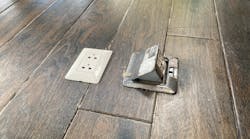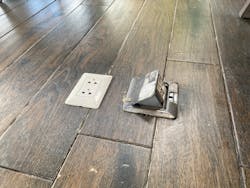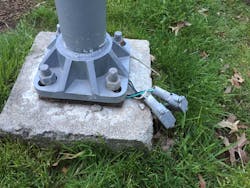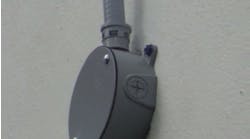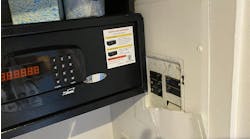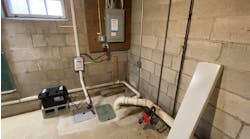All references are based on the 2023 edition of the NEC.
Floor Outlet Follies
I spotted these interesting outlets on the floor of an outside seating area for a restaurant. In seating areas, Sec. 406.5(H) prohibits receptacles from being installed in a face-up position unless installed in either a listed floor box, an assembly listed for countertop applications, an assembly listed for commercial or household furnishings, or an assembly listed as a furniture power distribution unit. Section 314.27(B) requires listed floor boxes to be used for receptacles installed in floors. This receptacle appears to be mistakenly installed in a general-purpose device box rather than a listed floor box. Section 406.9(B) requires the use of weather-resistant (WR) type receptacles in damp locations such as this. For 2023, Sec. 406.4(G) requires physical protection for floor receptacles to allow floor-cleaning equipment to be used without damaging the receptacle. Running a floor-cleaning machine over this receptacle could cause serious damage to the receptacle. Additionally, Sec. 210.8(B)(6) requires GFCI protection for these receptacles. This incorrectly installed, face-up floor receptacle certainly poses an increased risk of shock and fire. At least the installer took more care when installing the tel/data outlet. That pop-up enclosure seems more appropriate for installations in floors.
Raceway? Who Needs a Raceway?
This installation was located along a busy pedestrian walkway, and those exposed wires pose a great risk of shock if their insulation gets compromised. Section 300.12 requires raceways to be continuous between boxes, conduit bodies, fittings, enclosures, or outlets. These two rigid PVC conduits are just flapping in the breeze here without being secured to anything. Section 300.3(A) permits the installation of single conductors only where installed as part of wiring methods specified in Chapter 3. These unprotected conductors are exposed to damage from sunlight, rain, snow, ice, lawn mowers, weed trimmers, rodents, and any other types of damaging forces you might imagine. Section 310.10(D) requires insulated conductors installed where exposed to the damaging rays of the sun to be either listed as sunlight resistant or be covered with an insulating material such as a sleeve or tape that is listed as sunlight resistant.
Where PVC conduit is subject to physical damage, such as a grassy area that regularly gets mowed, Sec. 352.12(C) prohibits the use of PVC conduit unless Schedule 80 conduit is used as specified in Sec. 352.10(K). Hopefully the metal light pole is grounded and bonded properly in accordance with
Art. 250 to minimize the likelihood of it becoming energized and shocking a passerby.
